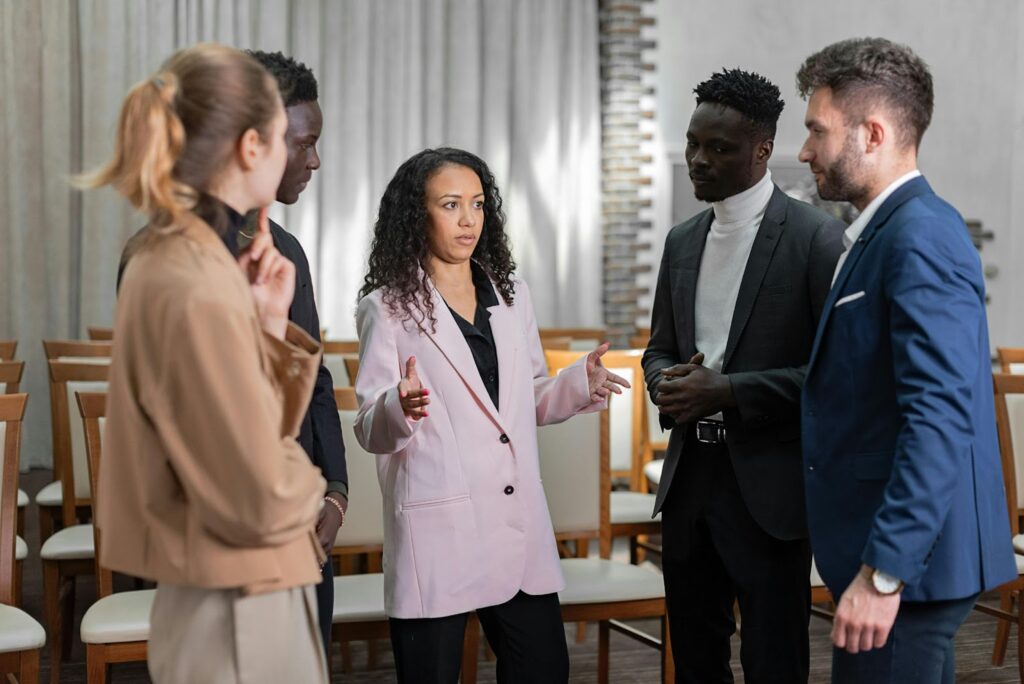Effective team communication is the backbone of any successful organization. It ensures that information flows seamlessly, ideas are shared freely, and everyone is aligned with the team’s goals. However, fostering an environment where such communication thrives is not always straightforward. This is where leadership plays a pivotal role.
Leaders set the tone for how communication is handled within their teams. They have the power to create a culture of transparency, trust, and openness, which encourages team members to communicate effectively. This article delves into the various ways leaders can foster robust team communication, from setting the tone and implementing structured channels to utilizing corporate team building activities and providing constructive feedback. Understanding and applying these strategies can significantly enhance team dynamics and drive organizational success.
Setting the Tone for Open Communication
Leaders play a crucial role in establishing a culture of open communication within their teams. By modeling transparent and honest communication, leaders set the standard for how team members should interact.
Modeling Transparent and Open Communication
- Lead by Example: Leaders should openly share information, updates, and feedback with their team. This transparency builds trust and encourages team members to do the same.
- Encourage Questions: Create an environment where team members feel comfortable asking questions and expressing concerns. This openness helps to address issues promptly and fosters a sense of inclusivity.
- Active Listening: Demonstrate active listening by paying full attention to team members’ inputs, acknowledging their contributions, and responding thoughtfully.
By consistently practicing these behaviors, leaders can cultivate a work environment where open communication is the norm, leading to better collaboration and team cohesion.
Implementing Structured Communication Channels
Structured communication channels are essential for ensuring that information is shared effectively and efficiently within a team. Leaders can implement these channels to streamline communication and prevent misunderstandings.
Importance of Clear and Structured Communication Channels
- Consistency: Regularly scheduled meetings, such as daily stand-ups, weekly check-ins, and monthly reviews, provide consistent opportunities for team members to share updates and discuss issues.
- Digital Tools: Utilize digital platforms like Slack, Microsoft Teams, and email for real-time and asynchronous communication. These tools help keep everyone informed and facilitate easy information sharing.
- Defined Processes: Establish clear protocols for how and when to communicate important information, such as project updates, feedback, and announcements. This clarity helps ensure that critical messages are not missed.
By implementing these structured communication channels, leaders can enhance clarity, reduce confusion, and promote a more organized and effective flow of information within the team.
Enhancing Team Dynamics through Corporate Team Building
Corporate team building activities are a powerful tool for improving communication and collaboration within a team. These activities help build trust, break down barriers, and create a more cohesive and dynamic team environment.
The Impact of Team Building Activities on Communication
Team building activities foster stronger relationships among team members, making it easier for them to communicate openly and effectively. By participating in these activities, employees learn more about each other’s strengths, weaknesses, and communication styles, which can improve overall team dynamics.
Examples of Corporate Team Building Activities
- Workshops and Seminars: Conducting workshops focused on communication skills, conflict resolution, and teamwork can provide valuable insights and practical tools for improving team interactions.
- Collaborative Projects: Activities like group problem-solving tasks, hackathons, or creative projects encourage team members to work together towards a common goal, enhancing their ability to collaborate and communicate.
- Social Events: Organizing social events such as team lunches, after-work gatherings, or company retreats provides informal settings where team members can bond and build personal connections that translate into better workplace communication.
Incorporating Team Building into Regular Routines
Leaders should integrate team building activities into the regular work schedule to maintain and strengthen team dynamics. This can include monthly team-building sessions, quarterly offsite events, or regular social gatherings. By making these activities a regular part of the team’s routine, leaders can ensure ongoing opportunities for team members to connect, communicate, and collaborate effectively.
By leveraging corporate team building activities, leaders can significantly enhance team dynamics, leading to improved communication, stronger relationships, and a more cohesive and productive work environment.
Providing Feedback and Encouraging Dialogue
Constructive feedback and open dialogue are essential for fostering effective team communication. Leaders can play a pivotal role in creating an environment where feedback is welcomed and acted upon.
Role of Constructive Feedback
- Timely and Specific: Provide feedback that is both timely and specific, focusing on behaviors and outcomes rather than personal attributes. This helps team members understand what they are doing well and where they can improve.
- Positive Reinforcement: Balance constructive criticism with positive reinforcement to motivate and encourage team members.
- Actionable Suggestions: Ensure that feedback includes actionable suggestions that team members can implement to improve their performance.
Encouraging Two-Way Communication
- Open Forums: Create opportunities for team members to share their thoughts and concerns, such as regular team meetings, suggestion boxes, or anonymous surveys.
- Active Listening: Demonstrate active listening by acknowledging feedback, asking clarifying questions, and showing empathy.
- Responsive Leadership: Act on the feedback received to show that team members’ input is valued and has a tangible impact.
By providing constructive feedback and encouraging open dialogue, leaders can foster a culture of continuous improvement and mutual respect within their teams.
Conclusion
Leadership plays a critical role in fostering effective team communication. By setting the tone for open communication, implementing structured communication channels, leveraging corporate team building activities, and providing constructive feedback, leaders can create an environment where communication thrives. These efforts lead to stronger team dynamics, enhanced collaboration, and ultimately, greater organizational success. It is essential for leaders to prioritize and continuously nurture communication within their teams to achieve long-term success.






